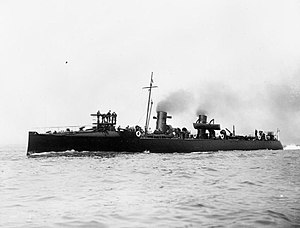HMS Bruizer (1895)

| |
| History | |
|---|---|
| Name | HMS Bruizer |
| Builder | Thornycroft, Chiswick |
| Launched | 27 February 1895 |
| Christened | Miss Kathleen Barnaby |
| Fate | Sold for scrapping, 26 May 1914 |
| General characteristics | |
| Class and type | Template:Sclass- |
| Displacement | 265 long tons (269 t) |
| Length | 200 ft (61 m) |
| Propulsion |
|
| Speed | 27 knots (50 km/h; 31 mph) |
| Complement | 53 |
| Armament |
|
HMS Bruizer[1][2][a] was an Template:Sclass- which served with the Royal Navy. She was launched on 27 February 1895 by John Thornycroft at Chiswick,[6] and was sold on 26 May 1914.[7]
Construction and design
On 12 October 1893, the British Admiralty placed an order for three torpedo boat destroyers (Ardent, Boxer and Bruizer) with the shipbuilder Thornycroft under the 1893–1894 shipbuilding programme for the Royal Navy as a follow-on to the two prototype destroyers (Daring and Decoy) ordered from Thornycroft under the 1892–1893 programme.[8][b]
The Admiralty did not specify a standard design for destroyers, laying down broad requirements, including a trial speed of 27 knots (31 mph; 50 km/h), a "turtleback" forecastle and armament, which was to vary depending on whether the ship was to be used in the torpedo boat or gunboat role.[10] As a torpedo boat, the planned armament was a single QF 12 pounder 12 cwt (3 in (76 mm) calibre) gun on a platform on the ship's conning tower (in practice the platform was also used as the ship's bridge), together with a secondary gun armament of three 6-pounder guns, and two 18-inch (450 mm) torpedo tubes. As a gunboat, one of the torpedo tubes could be removed to accommodate a further two six-pounders.[11][12]
Thornycroft's design (known as the Template:Sclass-) was 201 feet 8 inches (61.47 m) long overall and 201 feet 6 inches (61.42 m) between perpendiculars, with a beam of 19 feet (5.79 m) and a draught of 7 feet 3+1⁄4 inches (2.22 m). Displacement was 245 long tons (249 t) light and 301 long tons (306 t) full load.[3] Three Thornycroft water-tube boilers fed steam to 2 four-cylinder triple-expansion steam engines rated at 4,200 indicated horsepower (3,100 kW). Two funnels were fitted.[3][13] The ship's complement was 45 officers and men.[14]
Bruizer was laid down at Thornycroft's Chiswick shipyard, as Yard number 299, in April 1894.[3] The ship was launched on 27 February 1895, with the naming ceremony performed by Miss Kathleen Barnaby, the daughter of the S.W. Barnaby the naval architect.[15] Bruizer underwent sea trials on 29 March 1895, reaching a speed of 27.809 knots (51.502 km/h; 32.002 mph) over the measured mile and 27.97 knots (51.80 km/h; 32.19 mph) over a three-hour run.[16] She was completed in June 1895.[3]
Service history
Bruizer took part in the 1896 British Naval manoeuvres,[17] and was transferred to the Mediterranean Squadron during that year.[16] She remained part of the Mediterranean Fleet in 1901,[18] and also in April 1902 when she took part in gunnery and tactical exercises under the command of Lieutenant Robert Cathcart Kemble Lambert.[19] On 19 April 1907 the destroyer Ariel ran aground just outside Grand Harbour, Valletta, Malta. Bruizer rescued the crew of Ariel, all of whom survived.[20][21][2]
Bruizer returned to home waters in 1911,[16] serving with the Sixth Destroyer Flotilla in January 1912,[2] and then with a submarine flotilla at Lamlash through to 1913.[16][22]
She was sold for breaking for scrap to John Cashmore Ltd in 1914.[1]
Notes
References
- ^ a b Colledge 2006, p. 51
- ^ a b c "NMM, vessel ID 381456" (PDF). Warship Histories, vol ii. National Maritime Museum. Retrieved 23 October 2015.
- ^ a b c d e Lyon 2001, p. 43
- ^ Manning 1961, p. 36
- ^ Friedman 2009, p. 302
- ^ The Times (London), Thursday, February 28, 1895, p.4
- ^ "HMS Bruizer". pbenyon.plus.com. Retrieved 27 July 2010.
- ^ Lyon 2001, pp. 40, 43
- ^ Lyon 2001, p. 19
- ^ Lyon 2001, p. 20
- ^ Lyon 2001, pp. 98–99
- ^ Friedman 2009, p. 40
- ^ Friedman 2009, pp. 44, 290
- ^ Brassey 1902, p. 274
- ^ "Naval & Military Intelligence". Official Appointments and Notices. The Times. No. 34512. London. 28 February 1895. col B, p. 4. template uses deprecated parameter(s) (help)
- ^ a b c d Lyon 2001, p. 45
- ^ Brassey 1897, pp. 140, 148–149
- ^ "Naval & Military intelligence". The Times. No. 36433. London. 19 April 1901. p. 10. template uses deprecated parameter(s) (help)
- ^ "Naval & Military intelligence". The Times. No. 36744. London. 17 April 1902. p. 7. template uses deprecated parameter(s) (help)
- ^ Kemp 1999, p. 3
- ^ Lyon 2001, p. 48
- ^ "Fleets and Squadrons in Commission at Home and Abroad: Submarines". The Navy List: 269d. March 1913.
Publications
- Brassey, T.A. (1897). The Naval Annual 1897. Portsmouth, UK: J. Griffin and Co.
{{cite book}}: Invalid|ref=harv(help) - Brassey, T.A. (1902). The Naval Annual 1902. Portsmouth, UK: J. Griffin and Co.
{{cite book}}: Invalid|ref=harv(help) - Colledge, J. J.; Warlow, Ben (2006) [1969]. Ships of the Royal Navy: The Complete Record of all Fighting Ships of the Royal Navy (Rev. ed.). London: Chatham Publishing. ISBN 978-1-86176-281-8.
- Friedman, Norman (2009). British Destroyers: From Earliest Days to the Second World War. Barnsley, UK: Seaforth Publishing. ISBN 978-1-84832-049-9.
{{cite book}}: Invalid|ref=harv(help) - Kemp, Paul (1999). The Admiralty Regrets: British Warship Losses of the 20th Century. Stroud, UK: Sutton Publishing. ISBN 0-7509-1567-6.
{{cite book}}: Invalid|ref=harv(help) - Lyon, David (2001). The First Destroyers. London: Caxton Editions. ISBN 1-84067-3648.
{{cite book}}: Invalid|ref=harv(help) - Manning, T.D. (1961). The British Destroyer. London: Putnam. OCLC 6470051.
{{cite book}}: Invalid|ref=harv(help)
